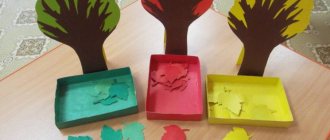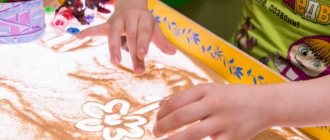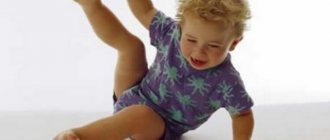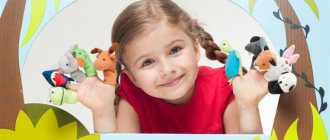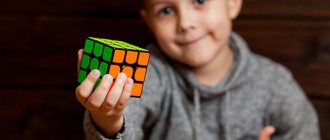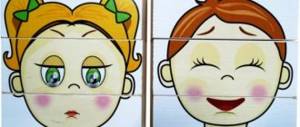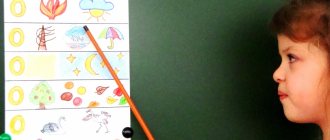Didactic games for the development of thinking
Thinking is one of the highest forms of human activity, and is also a socially determined, mental process inextricably linked with speech.
In the process of mental activity of each person, certain techniques or operations are developed: analysis, synthesis, comparison, generalization, specification. There are three types of thinking:
1) visual and effective (children learn about the world by manipulating objects);
2) visual-figurative (children can already imagine objects or phenomena in the environment);
3) verbal-logical (children use concepts and know how to reason).
Visual and effective thinking develops with particular intensity in a child from 3 to 4 years old. Children become familiar with the properties of objects, learn to operate objects, establish relationships between them, and also solve a variety of practical problems.
Based on visual-effective thinking, a more complex form of thinking is formed - visual-figurative. This is thinking in images, ideas, transforming a situation into a figurative form. It arises when the child has sufficient experience of practical actions and, instead of realities, he resorts to mental attempts to change the situation, imagining the necessary actions and the results obtained. Also, visual-figurative thinking allows the child, for example, to use schematic images or count in his head.
By the age of six to seven years, verbal-logical thinking, which is associated with the use and transformation of concepts, begins to develop more intensively in preschoolers. Thinking now appears not only in the form of practical actions, and also not only in the form of visual images, but, above all, in the form of abstract concepts and reasoning. However, verbal-logical thinking is not the leading one in preschoolers.
All types of thinking are closely related to each other. When solving problems, verbal reasoning is based on vivid images, and at the same time, solving even the simplest, most specific problem requires verbal generalizations from the child.
Reading fiction, designing, various games, modeling, drawing, etc., that is, everything that a child does before school, develops such mental operations as generalization, comparison, abstraction, classification, establishing cause-and-effect relationships. , understanding of interdependencies, ability to reason.
In the development of thinking and other mental processes of preschoolers, play is of great importance, the process of which is associated with the properties of objects (their shape, weight, size, color, features), and the performance of various actions with them. This promotes a comprehensive study of these subjects and creates conditions for the simultaneous interaction of various senses.
Examples of games for developing the thinking of preschoolers.
1) “Gather a big family”
Pictures depicting animals, vegetables, fruits, transport, etc. are selected. These pictures are laid out in front of the children and the task is given to gather large families.”
2) “Favorite food”
Pictures depicting animals and food for these animals are selected. Pictures of animals and separate pictures of food are laid out in front of preschoolers; each animal is invited to lay out its favorite food.
3) “Find the baby’s mother”
Pictures of domestic animals are laid out in front of the children: dog, cat, pig, cow, etc. and separate pictures: kitten, puppy, piglet, calf, etc., it is suggested to find the baby’s mother.
4) “Call it in one word”
Pictures are laid out in front of preschoolers, and an adult asks them to look at them and name them in one word. For example: train, plane, car - transport; fox, hare, bear - wild animals; apple, pear, plum - fruits, etc.
5) “Magic bag”
Toys are selected in the bag: red, blue, green, yellow. Pictures depicting: a red apple, a blue cloud, a green grasshopper, a yellow chicken are laid out on the table; preschoolers are invited to choose friends for them by color by taking out the corresponding toys from the bag.
6) “Gather friends”
Children are given a set of pictures depicting various objects. The adult asks to consider them and put them into groups, i.e. suitable with suitable.
7) “Lay out the pictures”
Ready-made series of plot-based sequential pictures are used. Preschoolers are given pictures and asked to look at them. They explain that the pictures should be arranged in the order in which events unfold. In conclusion, the children make up a story based on the pictures.
8) “What’s extra?”
Select a series of pictures, among which three pictures can be combined into a group according to some common characteristic (animals, transport, flies, jumps, soft, cold, etc.), and the fourth picture is extra. Invite the children to find the extra picture. Ask why they think this way and how the pictures they left are similar.
9) "Alternation"
Invite preschoolers to draw, color, or string beads. Please note that the beads must alternate in a certain sequence, for example, by color: red, blue, yellow, green, etc. In the same way, you can suggest drawing a multi-colored fence, or laying it out on the table from multi-colored sticks, etc.
10) “Find the extra word”
An adult reads a series of words, for example: animals, vegetables, fruits, etc. and invites preschoolers to clap their hands when they hear an extra word; you can also choose a child who will explain why the word is extra, to which group he would associate it.
11) “Who is faster”
An adult, throwing a ball to a child, names a color, and the child, returning the ball, must quickly name an object of this color. You can also name not only the color, but also the quality (for example: taste, shape) of an object.
12) "Professions"
An adult shows children pictures of people’s professions and asks them to name what people in a certain profession do. For example, a doctor treats people, a builder builds houses, a teacher teaches something to children at school, etc. Showing can be replaced with facial expressions and pantomime.
13) “Tell me the other way around”
Offer your preschoolers the game “I will say a word, and you will also say it to me, only in reverse, for example, big - small.” You can use the following pairs of words: cheerful - sad, fast - slow, empty - full, smart - stupid, hardworking - lazy, strong - weak, heavy - light, cowardly - brave, white - black, hard - soft, rough - smooth and etc.
14) "Guess"
An adult asks you to guess which animal, vegetable, fruit, vehicle, etc. He says. It is imperative to give children a specific, clear description of each item. For example: This is a fruit. It is red, round, juicy (Apple).
15) “Guessing riddles”
Invite children to guess descriptive riddles on various topics (flora and fauna, natural phenomena, vegetables/fruits, objects, etc.) For example: Long-eared, shy, loves to eat carrots and cabbage (Hare); Red-haired, she has a fluffy tail, deftly jumps through the trees (Squirrel), etc.
16) “Migratory and wintering birds”
Preschoolers are presented with pictures depicting migratory and wintering birds, as well as two identical pictures depicting a tree. They need to put all the migratory birds on one tree, for example: swallow, starling, rook, cuckoo, lark, etc., and on another - wintering birds, for example: tit, sparrow, crow, bullfinch, etc.
17) “Flies, swims, crawls”
An adult gives children pictures depicting those who can fly, swim, crawl. Then he lays out pictures on the table depicting the sky, sea, grass and asks to match the animal, bird, insect, fish, etc. with the corresponding picture, asking the question: “What can he do...” (Bird, beetle... - fly; hare, grasshopper - jump...; snake, snail - crawl...)
18) “Find something similar”
Preschoolers are offered geometric shapes and various objects. The task is to form groups of objects based on their similarity to a certain geometric figure. For example, a circle is a ring, a lid..., a square is a box, a cube... etc.
19) "Domestic and wild animals"
Pictures depicting domestic and wild animals, as well as two pictures are laid out in front of the children: the first one shows a house, the second one shows a forest. They need to place domestic animals around the house and wild animals around the forest.
20) “Our favorite winter and favorite summer”
An adult lays out two pictures “Winter” and “Summer” on the table in front of the preschoolers, as well as pictures depicting various winter and summer clothes and accessories. Children need to relate to the season what people usually wear when it comes. (For example, “Winter” - fur coat, scarf, mittens..., “Summer” - shorts, T-shirt, hat...)
Author: Irina Bagmenko, Master of Preschool Education, Lugansk, Ukraine.
MAGAZINE Preschooler.RF
Card index of games and play exercises for the development of thinking in preschool children with mental retardationAnanyeva E.V. teacher - defectologist MKDOU d/m 428
Children with mental retardation have a delayed rate of formation of mental operations, which in the future will negatively affect their learning at school. It will be difficult for such a child to master the general education school curriculum. Therefore, it is very important that kindergarten teachers, as well as parents, begin to work as early as possible on the development of thinking in children with mental retardation. In preschool childhood, the leading activity for the comprehensive development of a child is play. Therefore, this consultation presents a selection of games aimed at developing thinking in children with mental retardation.
Thinking is a socially conditioned mental process that is inextricably linked with speech. In the process of mental activity, certain techniques and operations are developed (analysis, synthesis, comparison, generalization, specification).
There are three types of thinking:
- visual-effective (cognition through the manipulation of objects)
- visual-figurative (cognition through representations of objects, phenomena)
- verbal-logical (cognition using concepts, words, reasoning)
№
| Game and its contents | Leading thinkers operations | |
| 1 | Game “Find the same toy” Instructions: children are asked to find identical toys among those offered (arrange the toys in a row). Find identical toys in a group. We need to invite children to explain why they think that the toys are the same. | Comparison |
| 2 | Game "Wonderful bag" Instructions: Place several items in a linen bag. For example: 1 spool, button, rubber toy, 2 spoons. The child is asked to determine by touch what these things are, describe them and think whether any of them are the same. | Comparison |
| 3 | Game "Butterfly and Flower" Instructions: Butterflies want to find their flowers - to sit on a flower so that they cannot be seen and no one can catch them. Paying attention to the fact that the color of the butterfly and the flower match. | Comparison |
| 4 4 | Game "Geometric Mosaic" Children are asked to tell what geometric shapes the image is made of, how many there are and what color. Then lay out the same pictures from a set of geometric shapes, first by overlaying them on a card, then complicating the task: next to the picture, and then from memory. | Comparison |
| 5 | Game "Pyramid" (large) Tumbler pyramid with bright rings. Instructions: you need to string the rings onto the rod in any order, and then in ascending or descending order of their diameter or color. | Synthesis |
| 6 | Game "Mailbox" A box with figures is placed in front of the child; the figures are taken out. The teacher takes one of the figures and shows its base. He outlines the corresponding slot and lowers the figure into it. With a gesture he invites the child to continue working. Instructions: “Put all the pieces into the box.” | Synthesis |
| 7 | Game “What the artist drew” Instructions: Children are given natural objects, selected according to lexical topics (fruits, vegetables) or in random order. Each child talks about the object, highlighting its properties and characteristics. Initially, the object is named, then its characteristics are listed, and the children guess the object. | Synthesis |
| 8 | Game "What's missing here?" The child is offered object toys. Instructions: Look carefully at the four object toys and determine which object is superfluous and why. | Analysis |
| 99 | Game "Alternation" Invite your child to draw, color or string beads. Please note that the beads must alternate in a certain sequence. In this way you can lay out a fence of multi-colored sticks, etc. | Analysis |
| 9 10 | Game “Guess by Description” An adult offers to guess what (what vegetable, animal, toy) he is talking about and gives a description of this item. For example: This is a vegetable. It is red, round, juicy (tomato). If the child finds it difficult to answer, pictures with various vegetables are laid out in front of him, and he finds the one he needs. | Analysis |
| 11 | Game “Guessing Fables” An adult talks about something, including several fables in his story. The child must notice and explain why this does not happen. Example: Here's what I want to tell you. Just yesterday - I was walking along the road, the sun was shining, it was dark, the blue leaves were rustling under my feet. And suddenly a dog jumps out from around the corner and growls at me: “Ku-ka-re-ku!” - and she already pointed her horns. I got scared and ran away. Would you be scared? Yesterday I was walking through the forest. Cars are driving around, traffic lights are blinking. Suddenly I see a mushroom. It grows on a branch. Hid among the green leaves. I jumped up and tore it off. I came to the river. I look - a fish is sitting on the shore, its legs crossed and chewing a sausage. I approached, and she jumped into the water and swam away. | Analysis |
| 12 | Game “Nonsense” Offer your child drawings that contain some contradictions, inconsistencies, or violations in the behavior of the characters. Ask your child to find mistakes and inaccuracies and explain his answer. Ask how it really happens. | Analysis |
| 13 | Game “Words in Reverse” Offer your child the game “I will say the word, and you will also say it, only in reverse, for example, big - small.” You can use the following pairs of words: cheerful - sad, fast - slow, empty - full, smart - stupid, hardworking - lazy, strong - weak, heavy - light, cowardly - brave, white - black, hard - soft, rough - smooth and etc. | Analysis |
| 14 | Game “True - False” Name some situation and throw the ball to the child. The child must catch the ball if the named situation occurs, and if not, then the ball must be returned. You can offer different situations: dad went to work; a train flies across the sky; the cat wants to eat; the postman brought a letter; salted apple; the house went for a walk; glass shoes, etc. | Analysis |
| 15 | Game "Pyramid" (small) The “bee” pyramid consists of 3 parts. Instructions: Look carefully and think about the order in which you need to string the rings onto the rod in order for a “bee” to appear. | Analysis |
| 16 | Game "Traffic Light" The teacher introduces the children to the traffic light and shows how the light turns on. They remember what color they use and what actions they do. Instructions: Look carefully at what color the traffic light is, at what color of the traffic light you need to move, get ready, go. | Analysis |
| 17 | Game "Cut pictures" The game consists of asking the child to assemble a picture from parts. No special preparation of material is required for this game; you can cut the cards into pieces. You can complicate the game by first cutting the picture into 3-4 parts, then 6-7 parts, etc. | Analysis |
| 18 | Game "Puzzles with matches" Take a few sticks or matches and put them together to create a schematic representation of an object. After this, invite the child to mentally rearrange one or more matches so as to turn this image into another or somehow change it. | Analysis |
| 19 | Games "Pythagoras", "Columbus Egg" "Vietnamese game" "Tangram" "Magic Circle". | Analysis |
| 20 | Game "Pick a Pattern" Pieces are cut out from the picture with a certain pattern. It is necessary to find these pieces among those offered to the child. It is necessary to draw the child’s attention to the fact that not just any pieces can be placed in the places of the cut out rectangles, but only those that correspond to the pattern of the picture. To do this, you need to carefully compare the pattern elements in the main drawing and the cut out pieces. Games of this type become more complex by increasing the number of elements that need to be compared. | Analysis |
| 21 | Game “Pick the right fragment” This game is similar to the previous one. Only here the child is offered pictures not with a specific pattern, but plot illustrations. The illustrations also have cut out pieces. It is necessary to find these pieces among those offered to the child and “repair” the picture. | Analysis |
| 22 | Game “Who loves what?” Pictures with images of animals and food for these animals are selected. Pictures of animals and separate pictures of food are laid out in front of the child, and they are offered to “feed” everyone. | Analysis |
| 23 | Game "Zoo" The teacher builds a “zoo” and places animals in one carriage and birds in the other. Instructions: Look carefully, think and find a house for animals and a house for birds. Put everyone in their place. | Generalization |
| 24 | Game “Name in One Word” The child is read the words and asked to name them in one word. For example: fox, hare, bear, wolf - wild animals; lemon, apple, banana, plum - fruits. For older children, you can modify the game by giving a generalizing word and asking them to name specific objects related to the generalizing word. Transport - ..., birds - ... | Generalization |
| 25 | Game "Mushroom Picking" The teacher places mushrooms of three colors on the floor (mushroom caps are red, yellow, brown), takes three baskets - red, yellow, brown. Instructions: In the basket you need to put mushrooms of the same color as the color of the basket. | Generalization |
| 26 | Game "Fourth wheel" Prepare objects or pictures that are related to groups such as toys, dishes, tools, fish, fruits, vegetables, berries, drinks, food, clothing, shoes, hats, furniture, transport, trees, animals, birds, electrical appliances. Choose 4 pictures from one group and one picture from any other group. Place them in a row on the table. Thus, it turns out that the main part of the pictures has one common feature, which allows them to be combined into one group. One picture does not have this feature and therefore differs from the rest. She is superfluous. The child needs to carefully examine all the pictures, find the odd one and explain his decision. | Generalization |
| 27 | Lotto “Color and Shape” To consolidate their knowledge of geometric shapes, children are given cards with images of geometric shapes. The presenter shows small cards with objects similar to certain geometric shapes. Children find objects that match their geometric shapes and place them on their cards. To reinforce primary colors and shades, color cards are used, where the child selects objects of the corresponding color. | Generalization |
| 28 | Game “Place the objects in their places” The teacher arranges the objects, the children examine them. Instructions: Children are asked to find and place an object that looks like a triangle, name the color of the object (for example: a pyramid looks like a triangle, red, etc.). | Generalization |
| 29 | Game “Find the extra picture” Select a series of pictures, among which three pictures can be combined into a group according to some common characteristic, and the fourth is extra. Invite your child to find the extra picture. Ask why he thinks this way. How similar are the pictures he left? | Generalization |
| 30 | Game “Find the extra word” Read a series of words to your child. Offer to determine which word is “extra.” Examples: Old, decrepit, small, dilapidated; Brave, angry, daring, daring; Apple, plum, cucumber, pear; Milk, cottage cheese, sour cream, bread; Hour, minute, summer, second; Spoon, plate, pan, bag; Dress, sweater, hat, shirt; Soap, broom, toothpaste, shampoo; Birch, oak, pine, strawberry; Book, TV, radio, tape recorder. | Generalization |
| < Previous | Next > |
